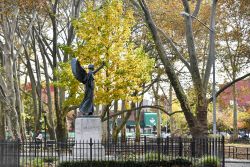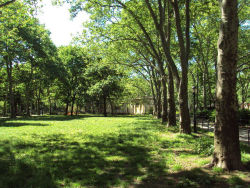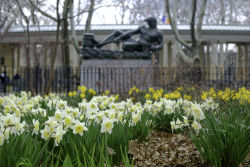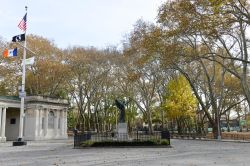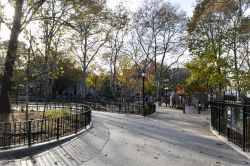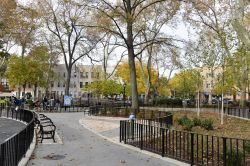Msgr. McGolrick Park
The Daily Plant : Thursday, March 9, 2006
Parks Remembers A Naval Battle, A Brilliant Designer, And The History Of Parks
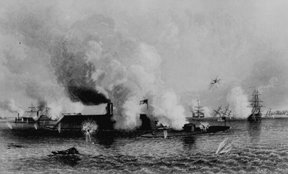
Today marks the 144th anniversary of the Civil War naval battle between the ironclad ships Monitor (built in New York City) and the Confederate Merrimack. A statue in Brooklyn’s Monsignor McGolrick Park stands in memorial to the ship and its designer John Ericsson, and another monument in Battery Park honors Ericsson for all his achievements, including the Monitor.
At the outbreak of the American Civil War, the Union had no choice but to abandon the Norfolk Navy Yard at Portsmouth Virginia. Before leaving, however, they substantially destroyed and sank the steam-powered ship Merrimack. Confederate engineers raised the hull, rebuilt the Merrimack as an ironclad warship, and renamed it Virginia.
Word of this deadly innovation reached the north and set Swedish-American engineer and inventor John Ericsson (1803–1889) to action. His formidable resume made him a well-qualified candidate to help the Union at this crucial juncture in history. Ericsson was interested in engineering from an early age and served in the Swedish Army. In 1836, he invented and patented the screw propeller, a device that vastly improved steam vessel travel, and made Ericsson prosperous. Approached by the United States Navy, Ericsson came to the United States in 1839. His design for the United States Navy frigate Princeton united many of his technological inventions, including state-of-the art screw propellers, smokestacks, ventilators, optical instruments, and gun carriages.
The Monitor represented the culmination of all of Ericsson’s prior inventions and the addition of metal plates or "iron cladding" to the outside of the ship changed naval warfare forever. This famous story of the first "ironclad" battle appears in most high school history books, however, what most people do not realize is that Ericsson built the Monitor in what is now New York City. The ship itself was built in Greenpoint, Brooklyn at the Continental Iron Works, and the ship’s engine and machinery were fabricated in Greenwich Village at the Delamater Iron Works. The keel was laid on October 15, 1861, and within an astounding 100 days, the Monitor was launched from Greenpoint on January 30, 1862.
This proved to be "not a moment too soon" because, more than a month later, the cumbersome new ship had not yet reached Virginia. On March 8, 1862, the south’s ironclad ship Virginia (formerly Merrimack) turned the wooden Union ship Cumberland into toothpicks and ran aground the Congress. These ships constituted key elements of the northern blockade, however they stood powerless in the face of the south’s ironclad ship. On the next day, the Monitor, fresh from Brooklyn, arrived to settle the score.
The battle between the two ironclads raged for four hours. At close range the motley pair fired cannons that would have annihilated sailing ships, but the advanced armor on these new ships made their cannons useless. The battle ended in a draw.
Ericsson’s success led to the construction of similar vessels for military use by the Union and other countries. In 1869, he produced a fleet of 30 gun-boats for Spain, and in 1881, devised a submarine gun. His later years were dedicated to diverse scientific investigations, including experiments with solar power and its practical applications. For his efforts, he was given many honors in the United States and Sweden, and from other European nations. He died in New York City on March 8, 1889, 117 years ago yesterday.-written by John Mattera
QUOTATION FOR THE DAY
"I can resist everything except temptation."
Oscar Wilde
(1854–1900)
Check out your park's Vital Signs
Clean & Safe
Green & Resilient
Empowered & Engaged Users
Share your feedback or learn more about how this park is part of a
Vital Park System

